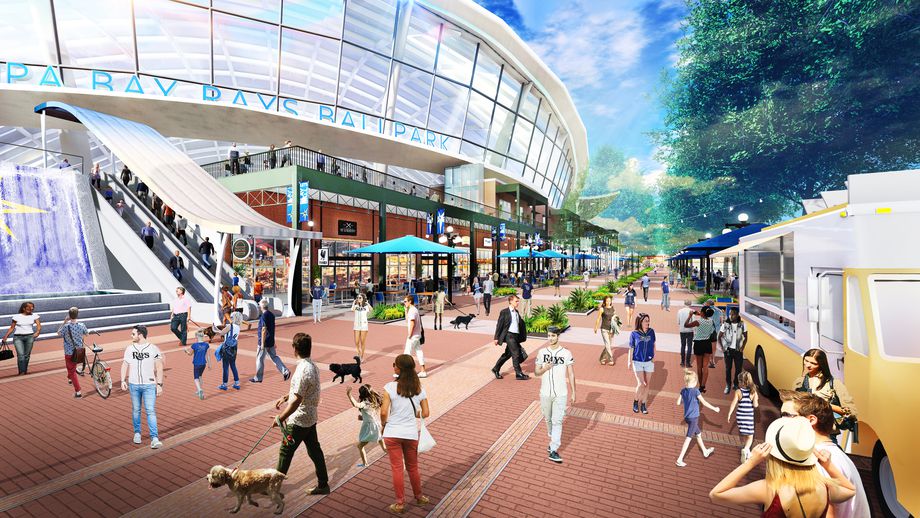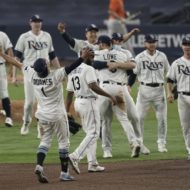
On Tuesday, the Tampa Bay Rays hosted a press conference in which artistic renderings of a proposed stadium in Ybor City were revealed. The purpose of the presser was simple, to gin up enthusiasm for the project within the community and outside the urban core.
As with anything, many positives were expressed — and unintentional negatives were intimated — during the 45-minute meeting. In the spirit of conveying coherent ideas, as opposed to writing one long convoluted article, I decided to break the subject into two separate categories — thus necessitating two different articles — one on the positives, and one on the negatives. This piece happens to be about the unfavorable aspects from the press conference, which took place at the Italian Club in Ybor City, blocks from the the proposed 14-acre site.
As expected, the renderings painted a picture of an innovative, and breathtaking (by the accounts of many) facility which played well to those in attendance, as well as those streaming the press conference online.
Days ago Noah Pransky (WTSP 10 Investigates, Shadow of the Stadium blog) made a prediction of how the presser would play out, and dare I say it largely followed the script?
- Rays have thought of everything and they think their renderings are awesome.
- Pics took politicians’ breath away – they love them.
- But a lot of work lies ahead – they need businesses and the community to step up with money if this is going to happen.
A few crucial aspects of the team’s pitch were intentionally left off the agenda though, most notably a discussion about how to fund the project.
Stadium costs
The initial price tag for the proposed facility will be upward of $892-million, far exceeding Principal Owner Stu Sternberg’s initial “highball” estimate of $800-million. The costs break down into $809-million for the stadium itself and another $83-million for what the team calls “necessary infrastructure” improvements, including public realm and safety improvements, as well as mobility and resiliency improvements. The glass-domed roof will account for 30% of the total cost, roughly $245-million. Not included in cost estimates, however, are those associated with the relocation of the TECO substation, site acquisition, and the money owed to the City of St. Petersburg for the remaining balance on the stadium per the usage agreement, not to mention the cost of demolishing Tropicana Field.
The additional costs, assuming the Rays don’t pay for them on their own, bring the total price tag closer to $915-million for a stadium the team suggested it would contribute more than $150-million toward, but less than $300-million. Let’s instead say Sternberg commits anywhere from $250-million to $299-million — which clearly is a big “if” at the moment — that leaves Hillsborough on the hook for at least $616-million.
Flippant as he may be, Sternberg must be aware that $600-$700 million in public subsidies is a non-starter. And since the team hasn’t settled on a firm contribution yet, they clearly are playing negotiating shenanigans.
Stadium costs aside, Rays President Brian Auld conceded that the team has no answers on how to pay for the stadium, although he was quoted as saying, that it’s a “very compelling investment opportunity” for everyone in the room and is open to creative funding.
#Rays Prez Brian Auld says team has no answers on how to pay for $892 million ballpark tab. Says its a “very compelling investment opportunity” for everyone in the room and is open to creative funding.
— Noah Pransky – WTSP (@noahpransky) July 10, 2018
Rays executives had anywhere from five months (when they announced their preferred stadium site) and a decade to come up with funding ideas for a stadium, yet they waited until there are 5-1/2 months left in the MOU window to hammer out a deal. In plain English, the Rays have a park they want to build, but they don’t know how they will get it done.
It’s a stunning, albeit funny, admission that befuddled many.
If you propose something that’s going to cost $892MM, maybe have an idea on how to pay for it. Just spitballing here. https://t.co/D6dfnzheIi
— Austin Atkinson (@AustinBAtkinson) July 10, 2018
Really gotta love the chutzpah of saying “Our business model requires somebody building us a $900m stadium. Any takers?”
— Field of Schemes (@fieldofschemes) July 10, 2018
Let’s stop dancing around the numbers. For an $890 million ballpark, 290 million will come from the private sector and 600 million will need to be made up by the taxpayers. This is based on factual data and years of analytics on the subject. @970wfla @noahpransky
— Rob Canton (@RobCanton) July 10, 2018
Unacceptable @EmptySeatsPics. This is my view at opening pitch. Several empty seats seen in the VIP section. pic.twitter.com/zulBC1pUvn
— Mark Weathers (5-4) (@markweathers15) July 10, 2018
$892-million for a shiny, new stadium and 5-1/2 months to cough it up. Look, a squirrel! #Rays #Stadium #Monorailhttps://t.co/hmpFedqMXB
— X-Rays Spex (@XRaysSpex) July 10, 2018
Always the intrepid journalist, Pransky pointedly asked Sternberg how he plans to build the stadium he’s been dreamt of, and talked about, for years:
Pransky: $892-million. Can you afford it?
Sternberg: (Glibly) Well, potentially.
Pransky: What do you need from the public sector?
Sternberg: I haven’t even looked at it at this point really.
Pransky: You guys haven’t looked at it all?!?
Sternberg: Not to the point that’s necessary. We’ve been focused on what you saw today, which is in itself a huge, huge undertaking.
I asked pic.twitter.com/MwcdNO5dXG
— Noah Pransky – WTSP (@noahpransky) July 10, 2018
Pransky also questioned if there was a scaled-down ballpark model from the “Cadillac” version he rolled out, to which he said the showcased rendering actually is the “Buick.” In all fairness, they could scale-down bells, whistles, and costs later if necessary.
I asked #Rays owner Stu Sternberg if there was a scaled-down ballpark model from the “Cadillac” version he rolled out today, and he said its actually a “Buick.” But they could later get to a point where they scale-down cost if necessary. #WTSP #StadiumSaga pic.twitter.com/YRQC0pKr26
— Noah Pransky – WTSP (@noahpransky) July 10, 2018
Then there was the query about what happens in five-to-six months if a deal doesn’t get hammered out? Sternberg, again, was glib, saying he hadn’t thought that far ahead.
The #Rays agreed to forgo very lucrative redevelopment rights at the Trop if they cross the bridge to Tampa. But don’t tell that to owner Stu Sternberg…when I asked him about it today, it sounded like he wanted his cake and to eat it too. pic.twitter.com/lDdJItT5bR
— Noah Pransky – WTSP (@noahpransky) July 10, 2018
It frankly was a disingenuous attempt to sell perception as reality. The team has thought long and hard about getting a stadium built which will be largely dependent upon public subsidization. Just slap together a few renderings and hope the general public will see the price tag as nothing more than a minor obstacle to overcome.
Neil deMause (Field of Schemes) put it another way:
So we are supposed to believe that the owner of a pro sports team, who for years has been demanding a new stadium as a way of improving his bottom line, went into designing and pricing out a new stadium with no thoughts at all of how it would be paid for or whether it would make money. Or the other possibility is that he thought, Hey, asking for hundreds of millions of dollars is a bad look — let’s just give the public lots of pretty pictures and hope they’ll be distracted enough not to worry about where the money will come from. I bet it’ll work on those stenographers at the Tampa Bay Times, anyway!
Since Tampa has been staked to tight budgets extending back to the recession of 2007/08, Mayor Bob Buckhorn didn’t sound too convinced the city could afford the price tag.
I asked Tampa Mayor @BobBuckhorn if the city can afford a $892 million #Rays stadium. He didn’t sound convinced: pic.twitter.com/ypqPmifmOo
— Noah Pransky – WTSP (@noahpransky) July 10, 2018
Buckhorn, however, allowed that a stadium is a want, not a need — one that is not worth leveraging the city’s future on.
It’s a lot of money. We’ve always known it was going to be a lot. I’m doing my best to try to get there, but I’m also willing to walk away if it doesn’t make sense…we don’t want to enter into a bad deal that’s going to burden my kids’ generation.
Tampa Mayor @BobBuckhorn tells me a new #Rays stadium in Ybor is a “want,” not a “need.” #WTSP pic.twitter.com/CTzfPF1s99
— Noah Pransky – WTSP (@noahpransky) July 10, 2018
Moreover, Hillsborough County has limited funds available as it pays down debt on Raymond James Stadium, Steinbrenner Field and Amalie Arena over the next few decades.
Suffice it to say, coming up with a financial package over the waning 5-1/2 months will be a monumental task. When you add in the mounting resistance from people of all stripes, progressive and conservative, paired with Mayor Kriseman’s acknowledgement that he isn’t too keen on extending the MOU window, that monumental task becomes far larger.
St. Petersburg Mayor Rick Kriseman released a statement Tuesday after the press conference. Pay specific attention to the verbiage at the end of the statement.
Today represents another step in the process for the Tampa Bay Rays as stadium renderings are necessary in order to generate enthusiasm in a community. This is also another step in the process for the City of St. Petersburg. We are continuing to plan for a future both with and without a stadium on the Tropicana Field site. I encourage all fans of the Tampa Bay Rays to enjoy the exciting product on the field as the Rays organization and stakeholders in Tampa and Hillsborough County work toward a resolution.
To whit, Kriseman likely is aware that professional sports franchises contribute just a fraction of a percent to the local economy. In turn, St. Petersburg will continue to move forward with or without the team. If you didn’t catch it though, the last four words — work toward a resolution — suggests that the Rays and stakeholders in Tampa and Hillsborough County are at odds with one another … that they are far from coming together with a resolution that pleases everyone involved. That’s not how mutually beneficial teams are made.
In conclusion
To quote the theme song from the hit 80’s comedy The Facts of Life,
You take the good
You take the bad
You take them both and there you have
The facts of life
The facts of lifeWhen the world never seems
To be living up to your dreams
Then suddenly you’re finding out
The facts of life are all about you
There are many great aspects to this ambitious project. Then again, the same can be of the unfavorable attributes. The facts of life, as it were. Finding a location and coming up with a design have proven to be easy and exciting, yet finding the money and the public will to build a stadium are proving to be an uphill battle. I, like many other fans, want my beloved team to play in a new stadium. Yet that facility must be in a more feasible location, less contentious location (more on that tomorrow) and should not depend the generation of new public subsidies.
One final quote,
…And so it goes.
— Kurt Vonnegut
